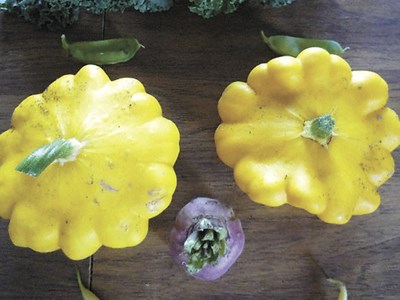Part of the beauty of the seed exchange that took place this past weekend at Market Square was the variety of heirloom seeds available from attentive gardeners who collect and package these treasures.
Heirloom seeds are unlike the hybridized varieties that are so commonly seen in stores. The crossing of particular varieties that, together, produce a higher and more vigorous yield has created hybrid seeds.
The trouble with these kinds of seeds is that the taste and nutritional components are replaced by a vigorous and more profitable yield. Only with the heirloom variety seeds are you guaranteed a taste reminiscent of grandma’s garden and the full nutritional punch of a multivitamin.
So how do you know if you are getting heirloom? Typically, it’s written somewhere on the packet. And these seeds tend to be cheaper, since the yield is not as great. But what you do get is the assurance of quality. Not to mention that you get a real connection from generations previous — these seeds have been hand-collected and packaged from gosh knows where.
Certainly if you’ve picked up a packet from the farmers at the Seed Exchange, they’ll be able to tell you a thing or two about the performance of the seeds.
When you get your seeds in the soil, a few things can foretell their performance.
The quality of your garden soil, the amount of sun and the drainage are all important predictors. Try experimenting with a few varieties — if your seeds are passed down from other green thumbs, then chances are, your seeds should do decently.
They have proven themselves in the area and know how to adapt to local climate. So take note of their performance. If they are impressive, then these are the seeds you’ll want to save for next year.
That’s another big difference. Heirloom seeds are “open pollinated,” which means insects, birds or the wind has pollinated them. This natural method also encourages biodiversity, since there are unforeseen genetic traits as a result of uncontrolled pollination.
This doesn’t mean you’ll have a Prometheus-style tomato that will get up and walk away. There are some breeds that are self-pollinizing that will propagate predictably. This means that seeds collected from the mature plant do much better if planted gain.
“Close-pollinated” seeds, like the hybridized type, often show lack-lustre results when collected and replanted from mature plants.
It may be hard to imagine that spring is around the corner. But it is, so start thinking about those seeds! It’s almost time.
Anne Boulton is an avid gardener who lives in Sudbury. Visit her blog at www.greenboots.ca or
contact her at [email protected].
Posted by Vivian Scinto
Join Sudbury.com+
- Messages
- Post a Listing
- Your Listings
- Your Profile
- Your Subscriptions
- Your Likes
- Your Business
- Support Local News
- Payment History
Sudbury.com+ members
Already a +member?
Not a +member?
Sign up for a Sudbury.com+ account for instant access to upcoming contests, local offers, auctions and so much more.
